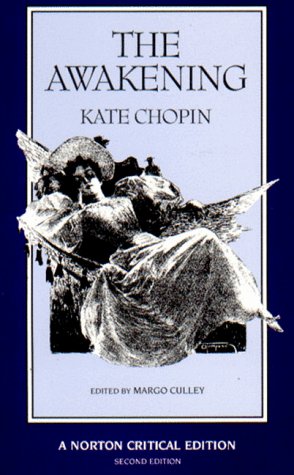

Title: The Awakening
Rating: 2 Stars
Title: The Yellow Wallpaper
Rating: 4 Stars
I read these two works closely together. There is a temporal linkage between the two. The Yellow Wallpaper is a short story by Charlotte Perkins Gilman, written in 1892. The Awakening is a novel (a pretty short one, nearly a novella) written by Kate Chopin in 1899.
On the surface, the two works of fiction seem completely different. The Yellow Wallpaper is, to put it mildly, creepy. It’s an example of Gothic horror. The narrator, writing in a journal, is a woman. She and her husband have rented a house for the summer. Her husband, a doctor, has diagnosed the narrator as having some kind of nervous condition (typically called hysteria in those times). Despite her need for outside stimulation and her desire to actually do something, she is confined to bed rest. There, she apparently begins to go mad. She becomes obsessed with the yellow wallpaper in the room. She begins to see moving patterns in the wallpaper and eventually thinks she sees a bent over woman crawling about the wallpaper, seeking to escape. The narrator, determined to help the woman, tears the wallpaper from the walls. When her husband finally opens the door, to his horror he sees the narrator creeping, on all fours, on the floor of the room. The husband faints and the woman continues to creep along the floor, stepping over the body of her husband.
The Awakening is much different. With a husband and two young children, Edna Pontellier is apparently a typical satisfied Southern belle housewife. While on a vacation, she meets and becomes attracted to a young man named Robert. At the same time, she hears an especially moving piece of music by the pianist Mademoiselle Reisz. To preserve both of their honors, Robert runs away to Mexico. All of this triggers an awakening in Edna. She sees the vacuousness of her life. She sees the passionless marriage to her well meaning (at least by 1899 standards) husband. She sees the artistic emptiness of her friendships. She even sees the mundane existence of being a mother to two young children.
Being awakened, she seeks to rebel. She sends the children to stay with their mother-in-law. While her husband is away on business, she moves out of their house. She conducts a love affair with a rather shallow young womanizer. Robert comes back from Mexico. After trying to stay away from Edna, Robert bumps into her and they each confess their love. Robert, again consumed with guilt, leaves once more. Edna, not willing to go back to her previous figurative state of sleep, goes out into the sea and drowns herself.
Stylistically, The Awakening is quite different than The Yellow Wallpaper. Reading The Awakening, it kind of reminded me a bit of Henry James. Like James, Chopin’s characters are all upper class sophisticates. Therefore, they are so well behaved that they nearly appear sterile. Beneath the elegant words and manners, emotions are turbulent.
In my own opinion, I much preferred The Yellow Wallpaper. Although The Awakening is elegantly written, the emotional distance of the characters’ upper class manners left me cold. It’s probably a problem with me, but the tragedies of the very wealthy sometimes ring hollow to me. The Pontelliers live on the most fashionable street in New Orleans. They vacation for an entire summer. They are planning on going on an international tour. They have many servants to take care of all of their needs. Is suicide really the only option that Edna has available to her? Speaking of which, it must have been the most languid suicide ever. It was the suicide of someone that had never worked a day in her life. The writing did not impel me to read. It was one of the longest 110 page works of fiction that I’ve read.
The Gothic horror of The Yellow Wallpaper is more my style. The story had much more tension. It had elements that propelled me forward. I cared much more about the narrator than I did for Edna.
The common theme that runs through these two works is feminism. Both written in the late 19th century, these were times when men were actively keeping women suppressed. Women were intentionally placed in clothes that were so constrictive as to restrain movement, if not breathing. Women were treated as terminally nervous cases where doctors would routinely order hysterectomies to calm their ostensibly hysterical nerves. Women were actively being both physically and emotionally repressed and had little power to change their state.
In this environment, both of these works are cries for feminist freedom. Edna, refusing to abide by conventions, begins to flagrantly flaunt them. Not willing to lapse back into the traditional roles that she’s just awakened from, she willingly sacrifices her life. The narrator, being actively repressed and her creative impulses stymied, manifests her desire to escape the restrictive life that she’s trapped in her by her imaginings of the woman trapped in the yellow wallpaper.
A couple of decades before women won the right to vote, these works are cries in the wilderness for women to break free of the chains in which they have been trapped.